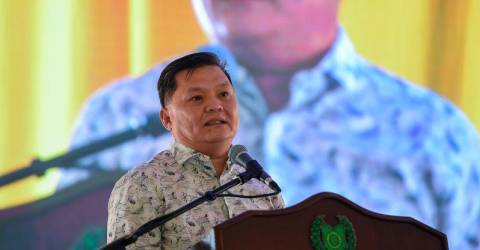ADVERTISE HERE

Photo taken during the columnist’s reunion party in Kuching back in 2020 shows (from left) Datuk James Chan, Datin Mary Goh, Joseph Kho and Bujang Dahlan Abon during a karaoke session.

I HAD first seen and sang on my very first karaoke box machine in mid-1979 on board the ‘RORO’ (roll-on roll-off) vessel ‘MV Toyofuji Maru No 7’, which was docked at the Datuk Amar Sim Kheng Hong Wharf of Kuching Port.
It was in the ‘Officers Mess’ section of the gigantic ship that had carried some Toyota Crowns, Celicas and DA Trucks for my company at the time NBT Toyota.
It was also the first time I had my taste of Japanese ‘sake’ out of a square wooden pine box, and partook of the ‘maguro’ and salmon sashimi served on board by the captain.
As ‘honoured guests’, my wife and I together with the then-Toyoda Tshuso Kaisha general manager of Sarawak, Hiroyuki Yamada and his wife Toshi, we were given a guided tour of the ship.
The word ‘karaoke’ itself is of Japanese origin, a combination of two words: ‘kara’ which means ‘empty’, and ‘okesutora’ which means ‘orchestra’.
It meant a type of interactive entertainment usually offered in clubs, bars, restaurants and homes where people could sing along to recorded music using a microphone piped out into an array of equipment as simple as just an amplifier with two speakers, to a high-end sophisticated hi-fi system costing thousands of ringgit.
Karaoke (although not known by that term then) has a long and colourful history. It began in the latter half of the 1960s, but a common set of equipment had only became widely available in the mid-1970s – so officially, next year would mark the 50th anniversary of the karaoke as we all know it today.
For what at that time was considered just another consumer craze or a form of self-entertainment, something that was considered a passing fad, it has indeed grown from strength to strength.
Its early origins can be traced back to 1961 when the USA television network NBC had featured (for two years) a series called ‘Sing Along with Mitch’, with host Mitch Miller (famous for his many children’s recordings like ‘This Old Man’, ‘Children’s Marching Song’, and ‘Do-Re-Mi’).
All this changed in the early 1970s when stored audible materials (Stereo-8 tapes, music cassettes), due to their portability and availability to record and duplicate music, began to dominate the music industry and had revolutionised the entertainment industry.
The karaoke-styled machine, as we know it today, was developed in various places in Japan.
The first basic ones had allowed patrons in pubs and bars to sing to an attached microphone reading a printed sheet of the lyrics over music played on Stereo-8 tapes, and broadcast over an amplifier and stereo speakers.
Only a limited selection of songs was available on the ‘playlist’ at the time.
Within a few short years, though, the karaoke craze was on – and has yet to stop till this day!
It is interesting to note that although it was a Japanese engineer named Shigeichi Negishi who had invented the mass produced ‘Sparko Box’ using eight-track cassette tapes in 1967, it was not till the early 1970s when major Japanese manufacturers Pioneer and JVC began producing their own versions of the ‘singing machine’ that would eventually become a sensation in pub and home entertainment.
In the early years, the prices were high but once consumer’s demand had soared, the mass production of these equipment spiked, and prices dropped as sales figures boomed.
Even though it was the Japanese who had given the world karaoke, it was a Filipino named Roberto del Rosario who took out the very first patent for the ‘sing-along system’ karaoke machine and is today recognised as the sole holder for the patent.
That was in 1975.
In 2020, the Japanese Karaoke White Paper, a report issued by the All-Japan Karaoke Industrialist Association had stated that the overall sales volume of the karaoke business in Japan that year was one trillion yen (Nippon.com).

Columnist with Sarawak’s first recording artist Rose Iwanaga in an outing at a local karaoke pub.
In the USA, the karaoke phenomenon had a humble beginning at a Los Angeles bar called ‘Dimples’ in 1982. In recent years, the overall business in the States had grown significantly with a rise in the popularity of ‘Karaoke Nights’ at pubs and fast-selling home systems, and it shows no sign of slowing down anytime soon (Quora).
At the height of its popularity in the mid-1990s, most observers reckoned that the ‘karaoke phenomenon’ was just a passing fancy and had a limited ‘shelf life’.
Today, no one I know in his right mind thinks that it is not here to stay!
The history of karaoke in Kuching had started in a very small way with a Japanese businessman by the name of ‘Obe-san’ who had worked with the Mitsui Company and who started Kuching’s first ‘private club’ initially meant for the small Japanese/Korean community based in Kuching.
This was sometime in the mid-1980s.
Later on Sakai-san, who had started the first Japanese restaurant Kikyo-Tei and then-Fima Rantei Restaurant at Crookshank Road, had also operated a small ‘club-like’ business – still operating to this day at Jalan Song Thian Cheok.
Kuching businessmen Peter Wong (better known as ‘Ah Juy’) and Morgan Tham (‘Kwang’) had, in 1989, introduced Kuching to its biggest and most luxurious karaoke club called ‘Solid Gold’ sited at Ban Hock Road; it later changed name to ‘Jade Solid Gold’.
It lasted almost 10 years and was, during its peak, the ‘in’ place to be seen.
On nights when it was packed and ‘Standing Room Only (SRO), a punter had to wait almost an hour to get a chance to go up on stage and belt out his requested song.
I had seen fistfights when customers had argued about ‘jumping queues’ for his song request to be played.
That said, the regulars did not even have to name their songs!
Solid Gold, at its peak, had the best and most modern karaoke sound system with a selection of songs in all languages, unmatched by any other joint of the same era.
The décor, ambiance and seating arrangements were up to international standards. Bookings were often needed to secure your seats.
The laser disc was first produced by an American company called MCA in 1978 and by the mid-1980s, became the dominant form of recorded videos both music and movies.
It became the gold standard for karaoke joints. However with the new invention of the DVD in the later part of the 1990s, many companies stopped producing laser discs.
With that also came the sprouting up of dozens of what are called ‘Karaoke Rooms’ within shopping complexes, shophouses and stand-alone buildings: they were as small as a two or three rooms outfit and as large as two or three floors of dozens of rooms.
Patrons could rent a DVD movie, sing out their karaoke favourites in small groups, or just use them as private ‘dating joints’ on an hourly charge or the price of a movie rental!

A photo of an early 1980s-era home karaoke system, a simple set with in-built speakers and amplifier, and points for the dual microphones.
This business model has thrived in Kuching and other parts of Sarawak since, and only grown stronger today, with more advanced equipment and extremely luxurious ‘digs’.
I have lost count of the number of these operations, but it is safe to say they would be in the high double-digits.
They extend even to the small roadside towns and the remote villages wherever there is electricity, beer and customers out for a night of fun and merriment!
Today, the local karaoke joint has become a focal point for the local community, the most accessible communal social platform and also the cheapest form of group entertainment.
What else can you do and where else can you go for something like spending RM50 each for a few hours of simple relaxation with friends, with drinks and food, and just paying for your share of good clean fun and merrymaking.
Happy singing – be it alone or in a group, stay safe and keep the peace!

 1 year ago
168
1 year ago
168



 English (US) ·
English (US) ·